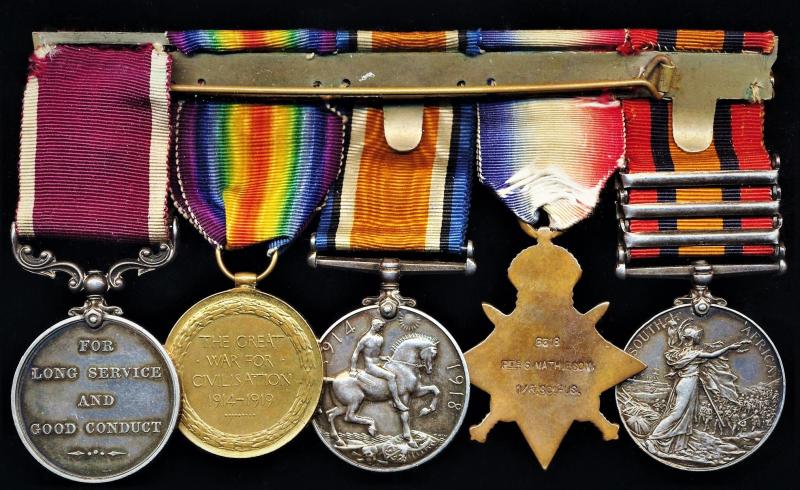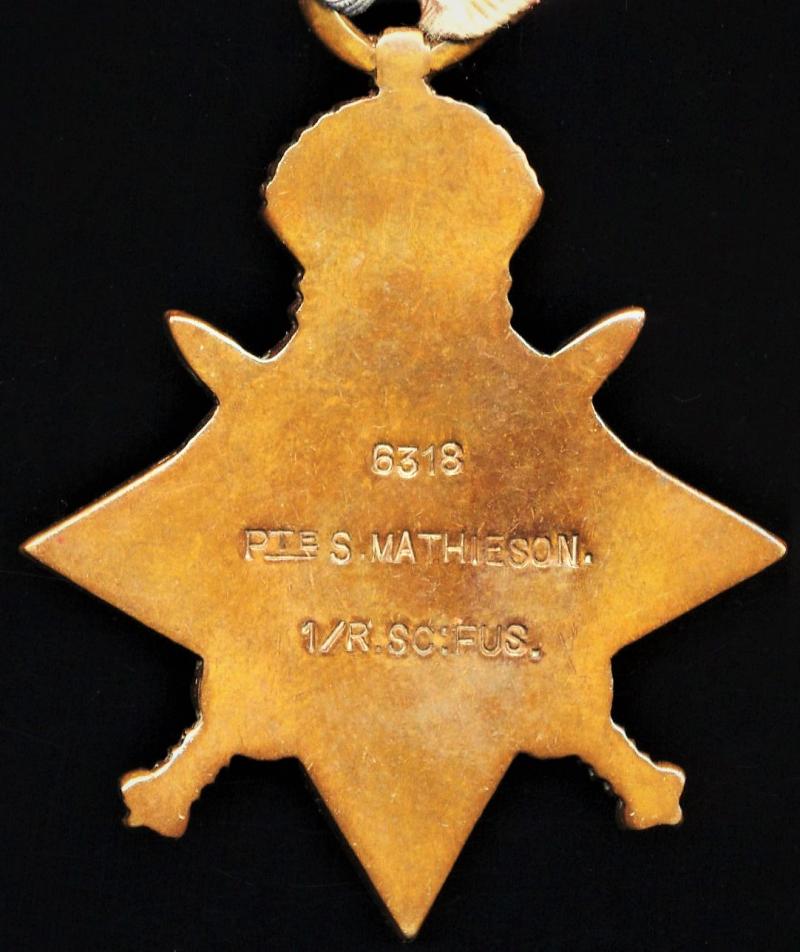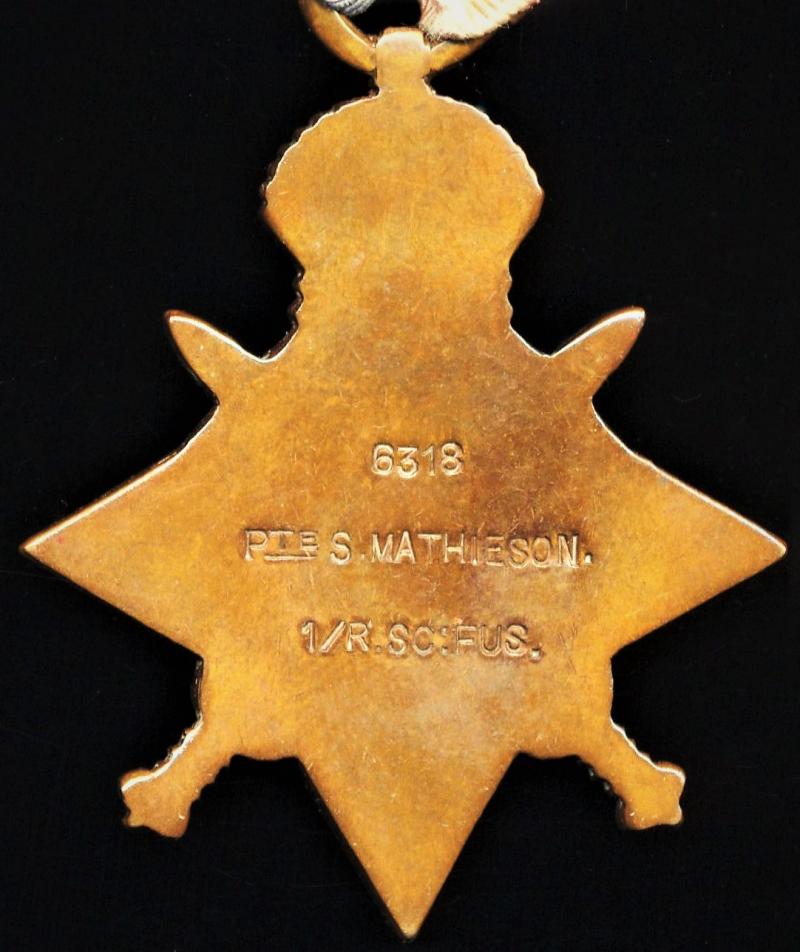A 'Casualty's' medal group of 5 to a 'Jock' who served pre-war in the infamous British 'Colonial Penal Colony' of Port Blair, Andaman & Nicobar Islands: Sergeant Stephen Mathieson, 1st Battalion Royal Scots Fusiliers
- QSA. Silver 'Tr' 'SA 1901' 'SA 1902' (6318 Pte. S. Mathieson. Rl. Scots Fus.)
- 1914 Star. No clasp (6318 Pte. S. Mathieson. 1/R. Sc. Fus.)
- British War Medal. Silver issue (6318 Pte. S. Mathieson. R. S. Fus.)
- Interallied Victory Medal (6318 Pte. S. Mathieson. R. S. Fus.)
- Military LS&GC. GV 1st issue (6318 Pte A.Cpl - S. Mathieson. R. Sc. Fus.)
Wounded-in-Action: The recipient is confirmed as being twice 'Wounded-in-Action' in France & Flanders during the Great War, as under;
- 03/03/1915: Gunshot & Shrapnel Wounds (GSW), to left side
- 20/05/1918: Gassed
Medals & clasp(s) verification: All medals verified as entitled per the respective medal rolls of the Royal Scots Fusiliers sources cited below;
- QSA Medal and 3 x clasps: Ref WO 100/180
- 1914 Star (with a dated clasp): Ref WO 329/2442
- BWM & Victory medals: Ref WO 329/990
- LS&GC Medal: Ref AO of September 1920 (Service papers refer)
Stephen Mathieson is shown in both his Medal Index Card and the respective 1914 Star medal roll confirm as being entitled to and issued with the dated clasp and roses for the 1914 Star
Stephen Mathieson, son of Margaret Mathieson (his notified next of kin who resided at, 10 Reid Square, off Russel Street, Ayr), was a native of the parish of Newton, Ayr, Scotland, where he was born circa 1881. James, enlisted in the British Army, at Ayr, Scotland on 18 September 1899, at which time he claimed to be 18 years & 5 months of age, and described himself as a 'Farm Labourer'. Prior to enlistment he had been serving as a volunteer with 3rd Battalion Royal Scots Fusiliers, and after his enlistment he was sent to the regimental depot of the Royal Scots Fusiliers, where, after completing his training, he was posted to 2nd Battalion Royal Scots Fusiliers, with which battalion he served in the South African War. Stephen was subsequently transferred to the 1st Battalion Royal Scots Fusiliers on 21 February 1903. While serving at the the British colonial penal colony of Port Blair, he re-engaged with the Royal Scots Fusiliers to complete 21 years service with 'The Colours' (the recipients service papers refer)
During his 'First period' of service with the Royal Scots Fusiliers, Stephen served as under;
- Home: 18/09/1899-30/07/1901
- South Africa: 31/01/1901-16/02/1903
- Home: 17/02/1903-03/02/1904
- India (Inc Burma): 04/02/1904-09/10/1910
- South Africa: 10/10/1910-30/03/1912
- Home: 31/03/1912-01/04/1912
British India's 'Devils Island': While serving in the East Indies (India & Burma), Stephen is confirmed as having served with the detachment of 1/RSF, that was posted from the battalion - then stationed in Rangoon, Burma - to the remote Andaman & Nicobar Islands in the Indian Ocean, where it provided security for the infamous British colonial prison colony located at Port Blair (in the years following the Indian Mutiny through to the Great War, a detachment of British infantry was rotated from the garrisons in British India, for service in Port Blair). The islands were referred to in India as the 'Kali Pani' or 'Black Waters' - a foreboding destination for any Indian unlucky to find himself incarcerated in the penal colony at Port Blair. At Port Blair, the detachment from 1/Royal Scots Fusiliers provided troops to guard the main prison, the imposing 'Cellular Jail', (purpose built and opened in 1906) where the convicts were mostly political subversives and early Indian freedom fighters
In spite of extending his terms of engagement at Port Blair in 1910 to complete 21 years service, on return to the United Kingdom, Stephen took a 'Free' discharge from the British Army on 1 April 1912 - and was placed on the Army Reserve 'Section D', at which time his 'character' was described as having been 'Exemplary'
The recipients extant service papers (held at The National Archives in the 'Burnt Series') show his service between 1913-1918, as under;
- Home (Section D Reserve): 03/01/1913-04/08/1914
- Home (Mobilized): 05/08/1914
- Home: 06/08/1914. Posted 3/RSF
- Home: 30/08/2014. Posted 1/RSF
- British Expeditionary Force France: 30/08/1914-06/03/1915 (1/RSF)
- Home: 07/03/1915-17/03/2018
- British Expeditionary Force France: 18/03/1914-26/05/1918 (1/RSF)
Although his service record shows service with the B.E.F from 30 August 1914, he is recorded on his Medal Index Card & the respective 1914 Star Medal Roll as having first entering theatre of war 'France' on 8 September 1914! Whatever the real date, he is confirmed beyond any doubt as serving under fire early after the start of the Great War - and being both entitled and awarded a dated clasp to his 1914 Star.
In March 1920, the recipient was residing at 37 Mill Street, Ayr, Scotland (service papers refer), and was in receipt of a service disability pension of 11 Shillings & 4 Pennies per week (he suffered 20% disability from the effects of being wounded (GSW & Gas attack))
A very large set of the recipient's service papers are extant and held in the 'Burnt Series' at The National Archives
The medals mounted in the swing style, suspended from contemporary silk ribands, and and as-worn by the recipient. The mounting bar retaining a long-hinged pin and clasp fittings
A fine Great War medal group to a 'Jock' who had prior served on the Indian Ocean 'Penal Colony' at Port Blair, Andaman Islands, and who later during the Great War had the misfortune to be wounded in 1915, & a victim of a 'Gas Attack' in 1918
Condition: Silver medals toned VF
Code: 22024
675.00 GBP







